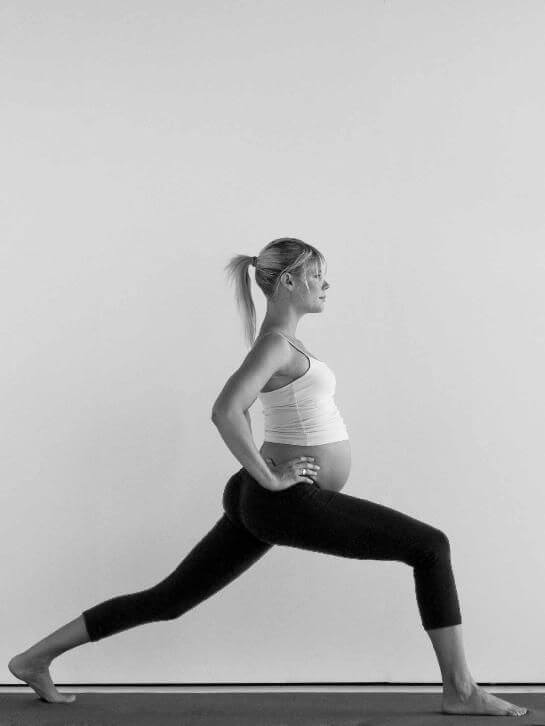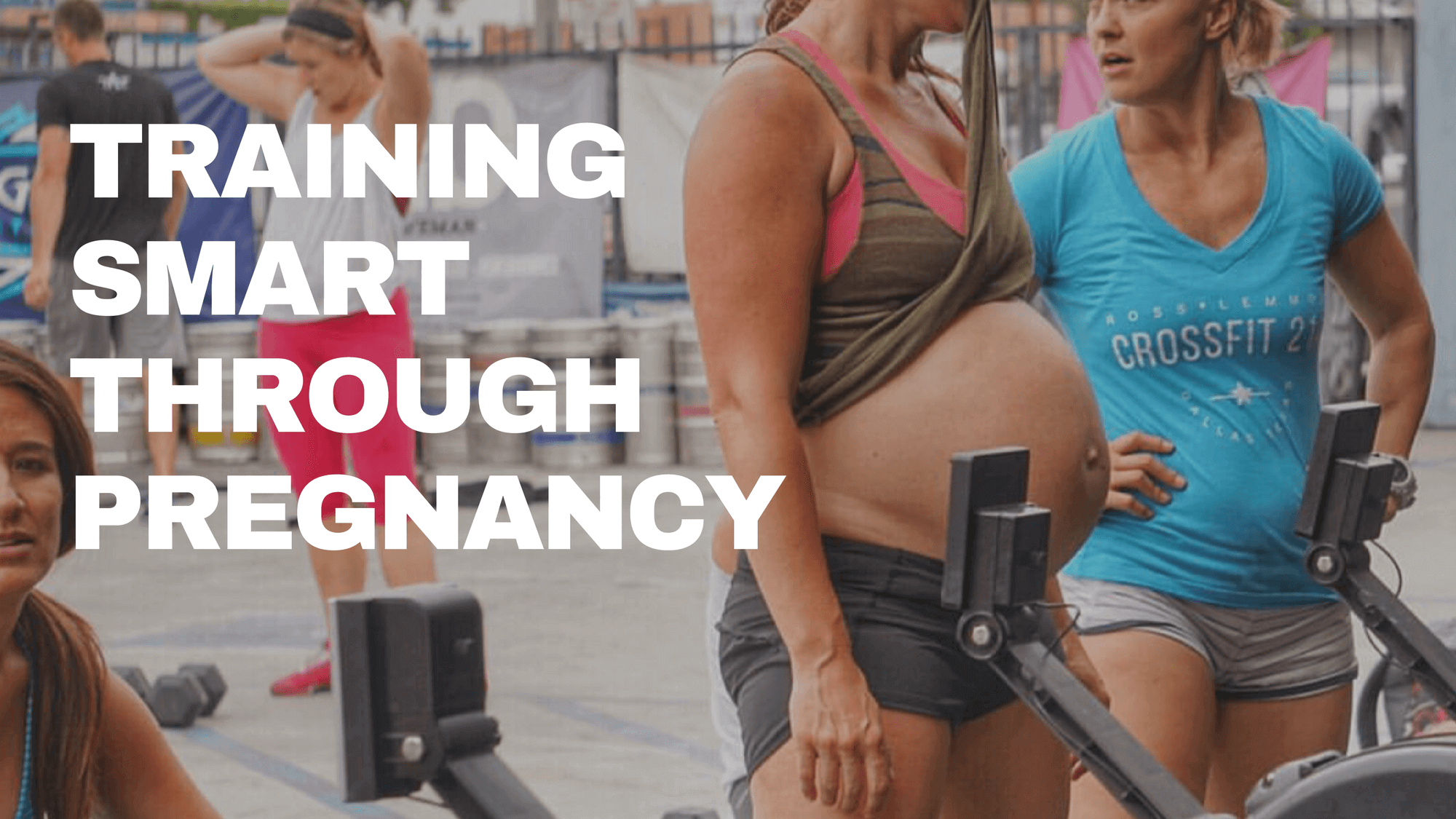I am all for women exercising during pregnancy. I have reaped the benefits of exercise through two pregnancies and have seen plenty of patients experience the same benefits. A few of these benefits include decreased musculoskeletal complaints throughout pregnancy, improved body mechanics and posture, prevention of gestational diabetes and preeclampsia, and stress reduction (1, 2, 3). In general, society seems to be catching on that pregnant women can and should be exercising during this time. Now it’s time to start training smart through pregnancy.
The point of exercise during pregnancy is twofold: benefit mother and baby in the same way that non-pregnant humans benefit from exercise; and to prepare for labor, birth, and the postpartum period.
That second part is probably more important than the first, but it’s the one that’s being overlooked. Yes, there are a ton of benefits to exercising during pregnancy, but I’d like to encourage women to train FOR something rather than just train.
Below are some examples of changes that happen during pregnancy and how to train to accommodate for these changes.
How to Train Smart Through Pregnancy
Postural Changes

The postural changes that occur during pregnancy mean that more of the mother’s weight is shifted anteriorly; strengthening the posterior chain helps to offset these changes.
What Mom experiences:
Common complaints associated with this include low back pain, knee pain, and a very obvious “pregnancy waddle.”
How to help with training smart through pregnancy:
Strengthening exercises for the posterior chain include squats, good mornings, and lunges. These exercises should be part of a woman’s routine. (Regular chiropractic care and physical therapy can also help women navigate the postural changes occurring in the body.)
Abdominal Expansion
What happens in the body: The entire abdomen expands to accommodate a growing fetus. This leads to stretching of the connective tissue between the abdominal musculature, typically resulting in a separation of the rectus abdominis muscle bellies (known as a diastasis rectus abdominis or diastasis recti).
What Mom experiences: Common complaints associated with this include low back pain and also a general feeling of weakness in the core. Weakness here can also impact the pelvic floor, as the core functions as a unit rather than in individual pieces.
How to help with training smart during pregnancy: Working on diaphragmatic breathing is one of the best things to do for the health of the abdomen. This includes breathing deep into the abdomen (all the way into the pelvic cavity). It also includes expanding breath into the sides and back. Breathing effectively will allow a woman to create more appropriate intra-abdominal pressure according to the principles of Dynamic Neuromuscular Stabilization (4). Using this breath as the base point of stability for all exercise is crucial throughout pregnancy and postpartum. Avoiding movements that could aggravate a diastasis and decrease the overall function of the core. This may include exercises such as sit-ups, toes-to-bar, v-ups, or L-sits should begin at the onset of pregnancy. Instead of hammering away at her abs during a workout, a pregnant woman can work on functional movement progressions (parts 1, 2, 3, and 4).
Training Smart Through Pregnancy – Mindset Changes
What happens in the body: As a woman prepares for labor, birth, postpartum, and the weight of bringing a child into the world, her mindset becomes an essential tool in preparation. Horror stories from well-meaning friends and family about how scary birth can be plague women from the minute they announce their exciting news. As a woman becomes a mother, there is a ton of information to sift through and a lot of mental preparation to do. The stressors of pregnancy can add up quickly.
What Mom experiences: Increased stress during pregnancy negatively impacts the mother, but can also negatively impact the fetus for years to come (5). Knowing that doesn’t help a woman decrease her stress! Women frequently report feeling overwhelmed during pregnancy, while others report anxiety or depression.
How to help: Preparing the mind for pregnancy, labor, birth, and the postpartum period (including motherhood in general) is as important as physical training the body. Incorporating a daily mindfulness practice is essential in helping women alleviate stress during pregnancy (6). But it is also a necessary component in helping to prepare for the unknown of labor and birth. ACOG has updated its guidelines to state that active labor does not begin until a woman has reached 5-6cms of cervical dilation (7). This means that even moms who are preparing for an epidural or other coping mechanisms during labor are going to need to be prepared to get most of the work of labor done outside of the hospital setting. Honing in on mindful practices can help a woman prepare to be in tune with her body throughout pregnancy and into the postpartum period. An easy way to do this is by starting or ending each day with 10 minutes of meditation. A woman can take that time to work on diaphragmatic breathing as a bonus, and allow her mind to clear as she connects with her baby.
Training the posterior chain, the functional core, and the mind are three ways that women can train smart during pregnancy rather than just working out with a baby on board.
Note: for postpartum fitness, help see this video.
About The Author of Training Smart Through Pregnancy
Dr. Lindsay Mumma is a chiropractor and the Regional Director for BIRTHFIT NC. She is a BIRTHFIT Senior Leadership Team member and authored the BIRTHFIT Trimester Series books. She owns Triangle Chiropractic and Rehabilitation Center in Raleigh, NC, where she works primarily with pregnant and postpartum women as well as athletes. Lindsay and her husband have two active boys.
References
-
Clapp, James F., III, and Catherine Cram. Exercising Through Your Pregnancy. 2nd ed. Omaha: Addicus , Inc., 2012. Print.
-
Hammer, R et al. Exercise During the Childbearing Year. J Perinat Educ. 2000 Winter; 9(1): 1–14. 28 Feb 17. https://www.ncbi.nlm.nih.gov/pmc/articles/PMC1595006/
-
Wang, C. et al. “A randomized clinical trial of exercise during pregnancy to prevent gestational diabetes mellitus and improve pregnancy outcome in overweight and obese pregnant women.” Am J Obstet Gynecol. S0002-9378(17)30172-2.10. 1016/j.ajog.2017.01.037 (2017): n. pag. gov. 1 Feb. 2017. Web. 9 Feb. 2017. <https://www.ncbi.nlm.nih.gov/pubmed/28161306>.
-
Kolar P, Sulc J, Kyncl M, Sanda J, Neuwirth J, Bokarius AV, Kriz J, Kobesova A.
“Stabilizing function of the diaphragm: dynamic MRI and synchronized spirometric assessment”, J Appl Physiol. 2012;42(4):352-622
-
Buss, C. et al. Maternal pregnancy-specific anxiety is associated with child executive function at 6–9 years age. Stress. 2011 Nov; 14(6): 665–676. 28 Feb 17. <https://www.ncbi.nlm.nih.gov/pmc/articles/PMC3222921/>.
-
Guardino, C. et al. Randomized Controlled Pilot Trial of Mindfulness Training for Stress Reduction during Pregnancy. Psychol Health. 2014; 29(3): 334–349. Published online 2013 Nov 1. 28 Feb 17. <https://www.ncbi.nlm.nih.gov/pmc/articles/PMC4160533/>.
-
The American College of Obstetricians and Gynecologists. Committee on Obstetric Practice. Approaches to Limit Intervention During Labor and Birth. Number 687, February 2017. 28 Feb 17. <http://www.acog.org/Resources-And-Publications/Committee-Opinions/Committee-on-Obstetric-Practice/Approaches-to-Limit-Intervention-During-Labor-and-Birth>.






